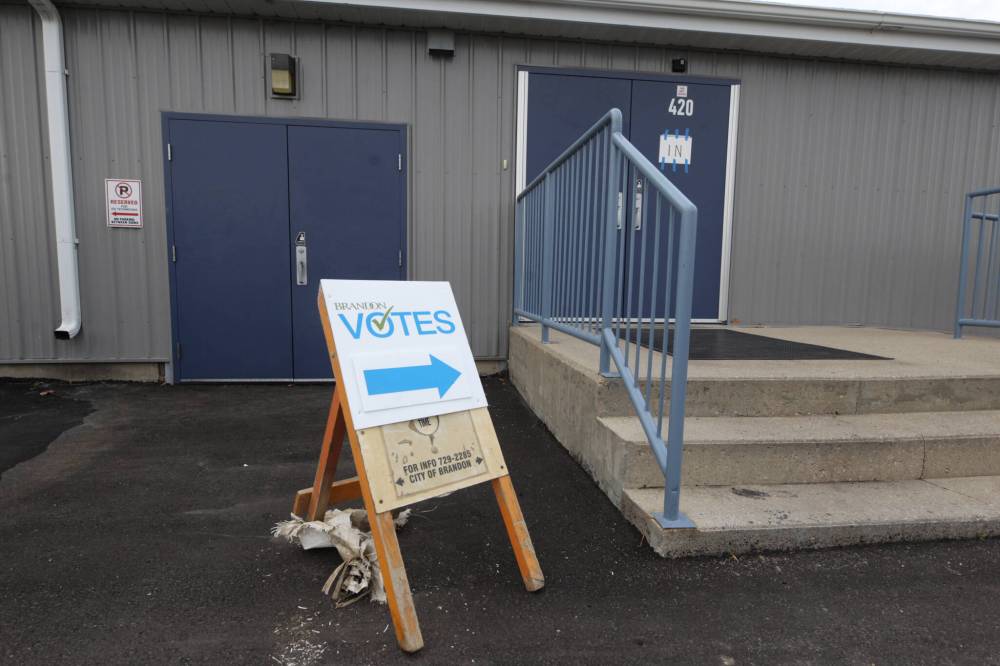Advance voting surpasses previous election numbers
Advertisement
Read this article for free:
or
Already have an account? Log in here »
To continue reading, please subscribe:
Monthly Digital Subscription
$1 per week for 24 weeks*
- Enjoy unlimited reading on winnipegfreepress.com
- Read the E-Edition, our digital replica newspaper
- Access News Break, our award-winning app
- Play interactive puzzles
*Billed as $4.00 plus GST every four weeks. After 24 weeks, price increases to the regular rate of $19.00 plus GST every four weeks. Offer available to new and qualified returning subscribers only. Cancel any time.
Monthly Digital Subscription
$4.75/week*
- Enjoy unlimited reading on winnipegfreepress.com
- Read the E-Edition, our digital replica newspaper
- Access News Break, our award-winning app
- Play interactive puzzles
*Billed as $19 plus GST every four weeks. Cancel any time.
To continue reading, please subscribe:
Add Free Press access to your Brandon Sun subscription for only an additional
$1 for the first 4 weeks*
*Your next subscription payment will increase by $1.00 and you will be charged $16.99 plus GST for four weeks. After four weeks, your payment will increase to $23.99 plus GST every four weeks.
Read unlimited articles for free today:
or
Already have an account? Log in here »
Hey there, time traveller!
This article was published 28/09/2023 (755 days ago), so information in it may no longer be current.
With two days left until advance polling stations close, early voting in this provincial election has already surpassed the total advance votes cast in the last election.
About 136,000 Manitobans have cast their ballots at advance polling stations since Sept. 23, Elections Manitoba said Thursday.
In 2019, the total number of advance voters was 112,814. Overall voter turnout four years ago sunk to 55 per cent of eligible voters, with a total of 478,926 votes cast. Voter turnout was slightly higher in the 2016 Manitoba election, at 57 per cent, up from 55 per cent in 2011.

The Riverview Curling Club polling station in Ward 8 sports a Brandon Votes sign outside of the front door on Wednesday afternoon. (Matt Goerzen / The Brandon Sun)
The trend has been for about 25 per cent of voters to cast their ballots in advance.
Advance voting was expanded this year, with more polling stations open before election day and Manitobans allowed to vote at any advance polling station in the province, regardless of where they live. More than 300 advance voting stations are open.
They will close at 8 p.m. Saturday. After that, Manitobans can vote anywhere in their riding on election day, Oct. 3.
Declining a ballot: process changed
Casting a blank ballot is an option for Manitobans who don’t want to support any candidate and would prefer to vote for none of the above. Manitobans can formally decline their ballot, but the process for doing so is different this year.
In previous provincial elections, voters who wanted to decline the ballot — essentially submitting their vote for none of the above — were instructed to write “decline” on the paper ballot. The introduction of vote-reading machines this year means that won’t work; declined ballots must instead be left blank, and will be placed in the ballot box and subsequently counted.
Instructions at polling stations have been updated to let voters know a blank ballot is treated as an official decline.
“The instruction is there, if they want to decline their ballot, they can just leave it blank,” said Mike Ambrose, director of communications for Elections Manitoba.
Declined ballots are counted along with rejected ballots. A ballot is considered rejected if the voter’s intention isn’t clear, such as filling in the circle beside the name of more than one candidate. The option to decline a ballot differentiates it from a spoiled ballot and allows it to be counted.
“How a voter chooses to vote is up to them, whether that is for a candidate or no candidate, all voters have that right,” Ambrose said.
Manitoba is one of four provinces that allows voters to submit declined ballots. They’ve been included in the final vote count since 1999.
Ontario-based Democracy Watch co-founder Duff Conacher, co-ordinator of VoteParty.ca and VotePromise.ca, said voting for none of the above is a valid choice, and election organizations should do a better job of informing the public about their right to decline a ballot.
“It’s much better than staying at home, and that is why the option is there,” he said.
“It is valid to look at all of the parties’ platforms and say, ‘I don’t think any of these platforms address my concerns.’ If you stay at home … you don’t count to politicians.”
In the 2019 provincial election, there were 2,334 rejected ballots and 1,159 declined ballots. Voter turnout was higher in the 2016 election, and so were the numbers of declined and rejected ballots: 4,023 declined and 2,590 rejected.
katie.may@winnipegfreepress.com

Katie May is a multimedia producer for the Free Press.
Our newsroom depends on a growing audience of readers to power our journalism. If you are not a paid reader, please consider becoming a subscriber.
Our newsroom depends on its audience of readers to power our journalism. Thank you for your support.














